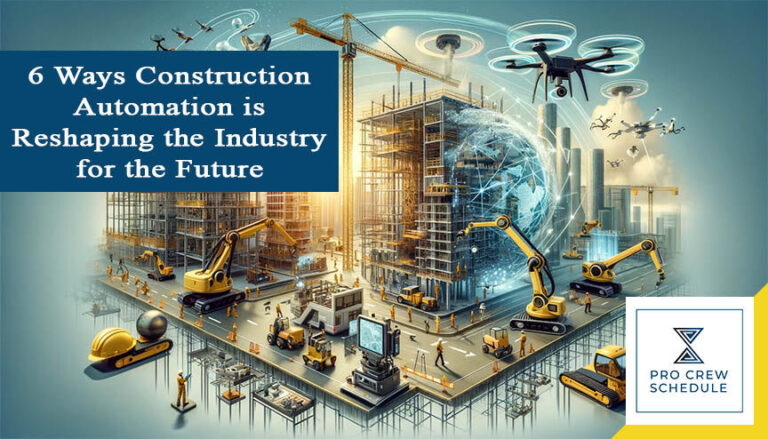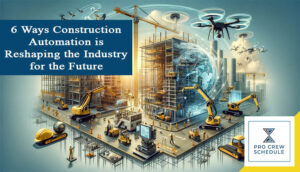The construction industry, one of the world’s oldest and most traditional fields, is slowly expanding to modern and innovative technology. Conventional practices in managing construction that are time-consuming and repetitive are now being automated for streamlined and more efficient processes. Digital transformation in construction is being introduced, and automation will play a major role in the next few years.
The continuous transformation of the construction industry will depend on automation in its many aspects, from automated design visualization and plan creation to automated forms and documentation and, ultimately, the act of construction itself. Automation of construction methodologies, whether for modular prefabrication similar to advanced manufacturing’s best practices or site-based construction robotics, will determine the industry’s success in fulfilling its current business goals: high demand for infrastructure and buildings and the incorporation of sustainability across the entire project lifecycle.
Construction automation has the same advantages to addressing opportunities and challenges that the manufacturing industry has helped resolve with the help of automation, including streamlined production time, material efficiencies, crew schedule management, and worker health and safety, as well as reducing environmental impacts, compensating for labor shortages, creating new design possibilities, and so on. In simple terms, automated construction has the potential to enable the construction industry to safely meet the global building and infrastructure demand of an increasing population. Rising technological developments and industry trends are green signs that now is the best time for automation to take hold in construction.
What Is Construction Automation?
Construction automation is the processes, equipment, and tools that use automated workflows to manage construction operations in building infrastructures and buildings. In some projects, tools are adapted to automate work that was previously done manually. In other projects, automated tooling enables new workflows to be transferred or developed specifically for construction.
Automation in construction can be implemented at various phases of a project lifecycle, beginning with the software-focused design stage, moving forward to the automated aspects of off-site and on-site construction, tracking the tasking and scheduling in a construction crew dispatch software, and capping by sharing collected data on the systems of finished buildings. Several major development strategies are required to realize these integrated feedback loops in software and hardware. For instance, collaborative robotics, new types of robots and automated machines, industrialized construction strategies, and real-time in-site sensing, feedback, and adaptation are among the emerging technologies developing to make construction automation a global reality.
How Can Automation Be Implemented in the Construction Industry?
Automation is reshaping the construction industry and setting us up for the future with improved efficiency. Automated technology is shifting increasingly critical for fulfilling roles and attracting a younger workforce as the current worker’s age, and the industry faces a labor shortage. Some of the ways automation can be applied to the construction industry are through the following:
1. Automating Manual Tasks On-Site and in the Office
If you’ve been in the construction industry for some time, you would know that labor shortage has been a persistent issue wherever you are assigned. Automation can be a new solution to this long-standing problem. Robots are filling workforce shortages by automating manual and repetitive tasks that are time-consuming. Here are some of the ways robots are helping the construction industry:
a. Rebar Tying Robots
For instance, rebar-tying robots are getting attention in the industry by automating a notably long and repetitive task. These robots can reduce labor hours, reducing labor costs.
b. Robotic Concrete Pouring and Paving
Robots are now learning how to pave, too. Robotic concrete pouring and paving are still in their early stages but well on their way to being a widely available construction technology.
c. Robotic Abrasive Blasting
Robotic abrasive blasting is still under development as a technology. These automated blasting systems could enhance site safety and project efficiency. Robots can be consistently accurate and precise. Hence, automated blasting could produce higher-quality surfaces and output overall.
d. Welding Robots
Welding robots are also among the most sought-after in the industry. Welding is dangerous for humans, so automation helps keep skilled workers safe so they can focus on more complicated welds instead of repetitive simple tasks. Various kinds of welding robots are already in use at construction sites worldwide.
e. Automated Brick-Laying Robots
Automated brick-laying robots are the earliest bots to hit the construction scene, and they continue to improve as the years pass. These robots help fill essential worker shortages on the masonry side of operations.
2. Automated Prefab Construction
a. Automated Manufacturing
Prefabricated construction companies are now more inclined to switch to automated manufacturing to improve their production operations. By automating these components, the companies can improve quality consistency, reduce production waste, yield better efficiency, and lower end-cons’ prices. This is due to the proficiency of robotic systems when repetitive tasks are the focus. Automated manufacturing equipment can create identical prefab components countless times nonstop without sacrificing the quality or wasting materials.
b. Automated Assembly
Automated assembly on the job site will be a more complicated application for prefab construction in the future. This will require advanced robotic equipment that is simultaneous with automation algorithms to make it work. Those technologies are still being further developed and tested. Nonetheless, this could one day lead to complete automated package prefab construction from the factory to the building site.
3. Autonomous 3D-Printed Construction
Automated 3D printing is one of the most cutting-edge applications for Artificial Intelligence in construction. This technology is also beginning to get introduced to a mainstream audience. Moreover, the world’s largest 3D-printed neighborhood is under development in Austin, Texas.
Almost 100% of construction-grade 3D printers are automated. At first, they would require a small team of technicians on-site to monitor the 3D printer. Afterward, workers will have to install roofing and interiors. 3D-printed construction sites are less environmentally harmful than traditional methods since less waste is produced in the building process. They also cause minimal disturbance around build sites and their neighborhood.
4. Construction Vehicle Performance and Fuel Monitoring
Artificial Intelligence (AI) can be used with Internet of Things (IoT) devices to automate the tracking of construction vehicle performance. This program can alert site workers of performance declines as the algorithm evaluates data collected from construction vehicles. This allows maintenance workers on-site to conduct tune-ups and mitigate identified risks of minor issues leading to major breakdowns.
AI and the (IoT) can also be applied to monitoring fuel usage on-site. Automated data analysis can provide insights about consumption that construction crews can use to optimize fuel usage and reduce expenses. For example, the culture of vehicle operators may lead to excessive downtime during operations. Automated fuel consumption monitoring can notify the supervisors and let workers address the issue to reduce costs.
Software-based fleet and fuel management systems are offered by various companies and can be utilized as either local software installations or cloud-based services.
5. Around-The-Clock site Security Drones
Automation technologies are great for guaranteeing high-quality security on construction sites. Break-ins can lead to damaged tools and equipment and potentially endanger trespassers’ lives. Construction drones can be implemented to monitor your site around the clock, even for teams that lack the personnel needed to have a 24/7 security guard.
With the help of construction drone technology, most monitoring activities can be completed at higher efficiency rates, making them quicker and more safety-oriented for the entire workforce. Construction sites have different degrees of hazardous areas, most especially during the early stages of a project. With drone technology, human workers no longer need to navigate dangerous regions of the job site.
6. Construction Management Software
Construction management software, the foundation of any project, helps residential and commercial builders avoid schedule delays and cost overruns by providing a 360-degree overview of a project regarding collaboration, documentation, and inventory management. Most construction management solutions allow users to coordinate scheduling and inventory, keep project expectations at the user’s fingertips, delegate tasks, and manage workflows whenever and wherever.
A standard construction management tool provides control and full visibility of task progress with a set deadline to avoid potential schedule delays. A company can manage construction projects and communicate with stakeholders, partners, suppliers, project owners, and subcontractors in one place.
With construction management tools like Pro Crew Schedule, no time is ever wasted. Let’s say the masonry team can’t complete their assigned task because of the delay in material delivery. With construction scheduling software, you can revise the scheduling, contact the painting team who are supposed to take over the project after the masonry work is completed, inform them about the problem, and contact the supplier involved. All this can be done within minutes with construction automation software.
Key Takeaway
Automation is rapidly transforming how managing construction sites and teams used to be, leading to improved productivity, safety, collaboration, sustainability, and more. Several technologies are still being researched and refined, but many are already going mainstream.
Automation in construction is not strictly about robots or drones that can help companies speed up manual work. Automation starts with correctly estimating resources and the human workforce, team scheduling, and communication with contractors, suppliers, and other project stakeholders.
Pro Crew Schedule is a construction management solution that is here to help you keep all your data connected and stored in one place, your tasks streamlined, and communication between teams flawless.







